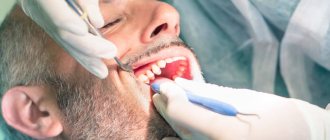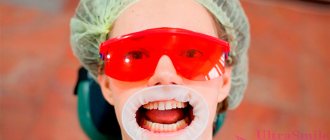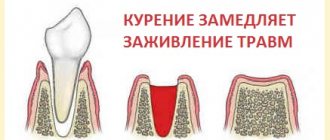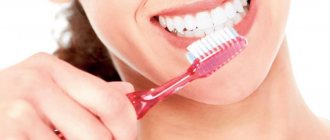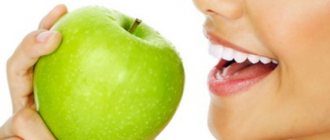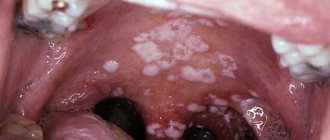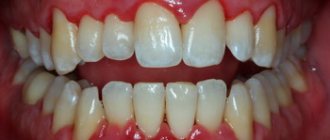When and how many times should you brush your teeth?
You need to brush your teeth at least 2 times a day for 2 minutes, and you should try to distribute this time evenly over the entire dentition. It is best to brush your teeth before breakfast, since microorganisms accumulate in your mouth after sleep. Without brushing your teeth, you risk introducing pathogenic microflora into the stomach and intestines. In the evening, it is recommended to brush your teeth before going to bed and not eat after hygiene procedures.
Algorithm for proper brushing of teeth with conventional (traditional, manual) and electric brushes
It is recommended to follow the correct teeth brushing sequence:
- 1. First, rinse your brush or electric brush head under running water and apply a pea-sized amount of toothpaste to it.
- 2. Brushing your teeth begins with the outer surface of the side teeth, moving towards the middle. Proper brushing technique means holding the brush at a 45° angle. When using a regular toothbrush, it is necessary to perform the correct movements, namely, 4-5 sweeping movements from top to bottom on the upper jaw and from bottom to top on the lower jaw. When using an electric toothbrush, you do not need to make any movements other than moving it from the back teeth to the front ones, holding each for a few seconds without applying excessive pressure.
- 3. Then you need to perform similar actions on the inside.
- 4. Next, clean the chewing surfaces, also in the direction from the back teeth to the front, making circular movements.
- 5. Next you need to massage the gums with a brush using gentle circular movements. Electric toothbrushes have special attachments for the gums, palate and tongue.
- 6. Clean the surface of the tongue with a special device that should be on the brush, or use a special scraper for this.
- 7. At the end, clean the interdental spaces with dental floss, using a new piece of floss for each gap.
- 8. Finish brushing your teeth with a mouth rinse; you can use special rinses, which the doctor will help you choose at your appointment.
Using an irrigator
An irrigator is a device that uses a certain pressure to deliver a stream of water or antiseptic to clean the interdental spaces and other hard-to-reach areas, washing away plaque from the tooth enamel.
It must be used after brushing your teeth. Its use is most effective in the following cases:
- Wearing braces,
- The presence of bridges, crowns and implants,
- Tendency to form stones in interdental spaces, crowded teeth
- The occurrence of almond stones, causing bad breath.
The irrigator cannot be used for acute infectious and inflammatory diseases of the oral mucosa, damage to the oral cavity, or periodontitis.
Causes of inflammation
Unpleasant sensations almost always occur after dental procedures. The main reason why inflammation occurs is the increased sensitivity of hard and soft tissues. Oral sensitivity can be an individual characteristic of the patient or a consequence of gingivitis, periodontitis, periodontal disease and other gum diseases. Often the cause of such problems is tartar.
Exacerbation of the pathology also provokes medical intervention, and after cleaning, gum inflammation intensifies. However, if you follow all the doctor’s recommendations, the unpleasant symptoms subside within a few hours or days.
The causes of gum inflammation after professional teeth cleaning can also be:
- enamel microcracks;
- caries;
- incorrectly selected toothpaste;
- toothbrush too hard;
- soft tissue injuries;
- mucosal lesions;
- inflammation of the gums;
- pulpitis;
- periodontitis.
How to use an irrigator correctly
The first step is to fill the reservoir with liquid.
There are special rinses and balms for the irrigator, but if they are not available, you can pour filtered boiled water. At the beginning of use, it is recommended to set the power of the irrigator to a minimum in order to prevent injury to the gums by a strong jet of water. You can gradually increase the pressure so that the procedure is comfortable. The irrigator is placed in the oral cavity, leaving a distance of several millimeters between the nozzle and the teeth. It is better to keep your mouth slightly open. Start cleaning from distant areas, moving the nozzle to the middle. The jet is directed from the gum to the crown at an angle to clean the enamel surface from plaque. Then - into the gum pocket to remove washed away plaque. You need to linger on the interdental spaces for a few seconds.
Dentists advise using the irrigator once a day. If teeth are prone to increased plaque and tartar formation, you can use the irrigator more often, including after meals. However, this device should not be abused, since too frequent exposure to a stream of water under pressure can disrupt the tight fit of the gums to the teeth, thereby increasing the distance between the teeth and gums.
After each use, it is necessary to rinse the irrigator with water, dry it and store it in a dry place. It is recommended to wash the irrigator once a month using special cleaning products.
Why you need to take good care of your mouth
With the introduction into practical dentistry and the improvement of various bone grafting techniques, implantation, as the most reliable method of restoring the dentition, has become available to patients with serious deficiency of bone tissue of the upper or lower jaw. Sinus lifting is considered one of the most minimally traumatic and safe operations in dentistry. There are two main types of this manipulation – open and closed sinus lift. After performing any of them, the patient must properly and regularly care for the oral cavity.
One of the main advantages of open sinus lifting is that the operation is quite effective even with pronounced atrophic processes in bone tissue. To raise the bottom of the maxillary sinus, the surgeon makes an incision in the soft tissue of the gums, which must be sutured after the remaining stages of the operation. The presence of fresh sutures in the oral cavity is one of the risk factors for postoperative complications, therefore, after an open sinus lift, you must strictly follow the doctor’s recommendations and ensure proper oral care.
With a closed sinus lift, trauma to healthy tissue is minimized, but this does not mean that after this treatment option the rules of hygienic oral care can be neglected. Although there are no incisions or stitches during a closed sinus lift, soft tissues are still injured when a small hole is made, through which the mucous membrane of the maxillary sinus is lifted and an implant is implanted. In order for the implant structure to be securely fixed, and the tissues adjacent to it not to undergo an inflammatory process, oral care after sinus lifting must be comprehensive and regular.
Oral care: main goals
Everyone knows that daily hygienic care of teeth and gums is an integral part of a healthy lifestyle. It helps keep your smile beautiful and radiant, your gums healthy, and your teeth strong. However, after performing a sinus lift, oral care is necessary not only for this. The main goals of careful oral care after this intervention are:
- Ensuring the patient's comfort in the postoperative period.
- Elimination of symptoms of inflammation, which is the body’s physiological response to even minor trauma to healthy tissue.
- Preventing postoperative wound infection.
- Creating favorable conditions for soft healing and bone tissue regeneration.
Comfort
Some patients believe that after an intervention in the oral cavity, hygienic brushing of teeth and other oral care measures will have to be forgotten for the first time. However, this is not true; you can and should feel comfortable even after performing bone grafting.
The main thing is to remember simple recommendations for proper brushing of your teeth, as well as regularly follow other doctor’s recommendations. Taking gentle oral care after a sinus lift will make you feel comfortable and confident immediately after surgery.
Elimination of the inflammatory process
Despite the low-traumatic nature of sinus lifting, the inflammatory process cannot be avoided after the operation. This is not a complication, since the appearance of slight swelling, tissue redness and soreness is considered a natural reaction of the body to even a minimal violation of the integrity of the skin and mucous membranes. Therefore, if you experience minor discomfort, pain and swelling, you should not panic.
The main thing is to properly care for your oral cavity and take medications prescribed by your doctor.
Prevention of infection
Poor oral hygiene is the main factor in the development of postoperative complications of infectious origin. Without proper care, pathogenic microorganisms multiply at an accelerated pace in the oral cavity, which, given the presence of a postoperative wound or fresh sutures, can cause serious complications.
This is why it is dangerous to forget about regular brushing of teeth and rinsing with antiseptics after performing any osteoplastic surgery. If the patient is responsible for hygienic oral care, then the risk of infectious complications after sinus lifting is minimal.
Recovery
The recovery processes in the body are influenced by many factors. When bone grafting is performed, it is very important that the osteoplastic material introduced to the patient takes root well, and that the tissues damaged during the operation heal quickly. These processes are influenced by following a proper diet, taking medications and vitamins in the postoperative period, as well as proper oral care.
If you do not pay due attention to oral hygiene after a sinus lift, the tissues will heal more slowly, and more time will have to be spent on bone regeneration, and therefore on the complete restoration of the tooth.
What does proper oral hygiene consist of?
After a sinus lift, the patient needs to pay attention to the following components of proper oral care:
- care of postoperative sutures (after open sinus lifting);
- regular teeth cleaning;
- rinsing or bathing with antiseptic solutions;
- using dental floss.
Caring for the oral cavity after a sinus lift is not particularly difficult, especially if the patient was responsible for personal hygiene before the procedure. Depending on the existing dental problems, the doctor may add any items that are necessary in this particular case.
What are the dangers of tartar?
In cases where tartar has already formed, treatment should be carried out immediately. Otherwise, it moves under the gums and leads to severe disorders of tissue metabolism in soft tissues.
As a result, acute or chronic gingivitis develops, the ligamentous apparatus of the tooth becomes inflamed and, as the most severe complication, periodontal disease develops - atrophy of the tissues that provide support to the tooth. As a result, a person who has developed subgingival tartar in the future faces the need to remove teeth that have lost stability and are no longer able to perform their functions.
Rehabilitation after cleaning
To prevent gum inflammation from starting after professional teeth cleaning, the patient should be attentive to himself and follow all the doctor’s recommendations regarding rehabilitation. Correct behavior and oral care will allow you to consolidate the results of cleaning for a long time, eliminate inflammation and prevent its complications.
Causes of complications from Air Flow and ultrasound
Operator inexperience
The first situation is the inexperience of the operator: for the operator, removing tartar and plaque is not the main activity. This often occurs in clinics where there are no hygienists specially designated for preventive measures, and everyone who is not too lazy does teeth cleaning! A general dentist can clean your teeth, an orthodontist, and a surgeon can. There is nothing wrong with this, but you need to understand that it is unlikely that an implant surgeon, whose main specialization is placing implants, will clean the patient’s teeth well and correctly and allocate the required amount of time for this.
The second situation is the operator’s inexperience: many clinics believe that dental hygiene (removing plaque and tartar) is a fairly simple medical procedure. Therefore, dental assistants or dental students in general are forced to do hygiene. This practice is widespread! Neither dental assistants nor students have the experience or qualifications to perform this treatment to a high standard.
The third situation is the inexperience of the operator: the dental hygienist does not have the necessary experience, and the work experience is low. Experience in this specialty comes after at least two years of practice.
Lack of time
Many clinics have regulated appointment times for patients. Especially in government and departmental clinics, the appointment time for one patient is limited and standardized. Network clinics, where business is more important than a human approach, and insurance companies that like to cooperate with networkers also often limit the time they can see a patient. But the situations in everyone's mouth are different. Some people have almost no stones, others have a lot. One has deep pockets, the other does not. One person has a good mouth opening and can sit for an hour and a half with his mouth open, for another it is difficult.
At Dial-Dent we do not limit the time allocated for each patient. During the consultation and examination, an experienced operator will see all the nuances and allocate as much time as necessary to carry out high-quality removal of tartar and plaque for a specific person.
Bad equipment, poorly calibrated equipment
Good equipment is quite expensive. There are additional costs for training personnel to use and maintain complex medical equipment. Many ultrasound machines do not have power adjustments or the adjustments are not flexible. Many ultrasonic devices create vibration trajectories that are dangerous to teeth. Old equipment. Inexpensive equipment. His service is bad. Frequent changes of operators (staff turnover) create conditions for potential problems when brushing teeth.
Device power is too high
This problem is due to lack of time and inexperience of the operator. In clinics where appointment time per patient is limited, the hygienist needs to increase the power of the ultrasound in order to clean teeth faster and meet the deadline.
If the operator is inexperienced, even with sufficient time, it is possible to make mistakes in the ultrasonic power settings. High power is preferable for an inexperienced operator: stones fly off quickly! But with high power, the risk of injuring teeth increases.
Worn or non-original attachment for an ultrasound machine
In ultrasonic devices, the consumable material is the nozzle. The nozzle is the tip that actually moves along the teeth, and to which the ultrasonic vibrations generated by the device are transmitted. The attachments are different. The better the clinic, the more attachments the hygienist uses. The attachments wear out when used. It is important that the operator monitors the wear of the nozzles and replaces them in a timely manner. In good clinics, nozzle wear is monitored using a special template on a regular basis. When working with attachments whose wear exceeds the established regulations, the tooth overheats and vibrations become uncontrollable. The risk of injury to tooth enamel or tooth nerve increases! Also often in practice there are situations when the device is expensive and good, but they try to save money on attachments and install analogues from China. This is unacceptable for Dial-Dent! We use only original ultrasonic attachments EMC Switzerland.
Saving on materials
An attempt to reduce the cost of the Air flow procedure through the use of non-original, and therefore low-quality, cleaning powders. And, as a result, damage to tooth enamel. EMS is the only company that has its own powder production in two chemical laboratories in Germany and Switzerland. We at Dial-Dent use only original materials.
The above disadvantages may be encountered by patients visiting a hygienist in other clinics using insurance or coupons. The main disadvantage is that other clinics are not responsible for the dental structures or fillings installed in you (we are talking about patients who undergo their main treatment at Dial-Dent). The quality of cleaning may vary, satisfactory or unsatisfactory. In a sense, it's a lottery, whether you get lucky or not. Why risk your health? Get your cleaning done by professionals with ten years of experience in a clinic where they care about the quality of equipment, materials and installed structures! Come for preventive care at Dial-Dent!
Make an appointment for a consultation by phone +7-499-110-18-01 or through the form on the website. You can ask questions about the prevention of dental diseases to the chief doctor of the clinic, Sergei Vladimirovich Tsukor, at
Folk remedies for relieving gum pain
Simple folk recipes will also help relieve gum inflammation and soothe the tissues:
- Prepare a decoction of sage and chamomile by taking a tablespoon of the raw material and pouring a glass of boiling water over it. The herbs must be infused in a steam bath for 15-20 minutes, and then rinsed throughout the day. As a rule, the pain noticeably subsides after the third rinse.
- A solution of baking soda can quickly eliminate gum inflammation after professional teeth cleaning. It is enough to dissolve a teaspoon of baking soda in a glass of water and rinse your mouth with the mixture several times a day.
For acute inflammation of the gums, dentists advise using the unique ASEPTA gel with propolis. The product with the waste product of bees provides action in four directions: antimicrobial, anti-inflammatory, healing and analgesic.
We hope that gum inflammation after brushing your teeth will not torment you, and this hygiene procedure will become your usual care and a way to maintain a healthy, snow-white smile.
Sources:
- Report on clinical trials to determine/confirm the preventive properties of commercially produced personal oral hygiene products: mouth rinse "ASEPTA PARODONTAL" - Solution for irrigator." Doctor of Medical Sciences Professor, Honored Doctor of the Russian Federation, Head. Department of Preventive Dentistry S.B. Ulitovsky, doctor-researcher A.A. Leontiev First St. Petersburg State Medical University named after academician I.P. Pavlova, Department of Preventive Dentistry.
- Report on clinical trials of anti-inflammatory balm for gums "Asepta" adhesive, St. Petersburg State Medical University, 2007
- The role of anti-inflammatory rinse in the treatment of periodontal diseases (L.Yu. Orekhova, A.A. Leontyev, S.B. Ulitovsky) L.Yu. OREKHOVA, Doctor of Medical Sciences, Prof., Head of Department; A.A. LEONTIEV, dentist; S.B. ULITOVSKY, Doctor of Medical Sciences, Prof. Department of Therapeutic Dentistry of St. Petersburg State Medical University named after. acad. I. P. Pavlova
Methods for treating tartar
Treating tartar on your own at home is not possible. Tartar removal is performed using practical and painless methods in the dentist’s office:
- Ultrasonic cleaning. This is the treatment of tartar with a scaler. The equipment generates low-frequency ultrasonic vibrations that destroy dental plaque. After this, the dentition is washed with a stream of water, and the enamel is ground and polished.
- Air Flow whitening system. In this case, cleaning is performed with an abrasive compound supplied under pressure through a special nozzle. The composition includes air, water and sodium carbonate. The equipment does an excellent job of cleaning the interdental space and effectively removes stubborn plaque.
- Laser cleaning. This is a non-contact technique that does not cause discomfort or pain. Tartar cleaning is performed with a directed laser beam, the remaining particles are washed out of the oral cavity with a water-air jet.
Treatment of inflammation
If gum inflammation appears solely as a result of professional teeth cleaning, several simple ways can reduce the negative manifestations:
- Do not eat rough foods within 24 hours after cleansing.
- For 12 hours, exclude drinks that stain the enamel - coffee, wine, natural citrus juices.
- Immediately after cleansing, avoid drinking too hot or cold drinks for 2-3 hours.
- When you get home, immediately replace your old toothbrush with a new one and do not use it for more than 3 months.
- Visit your dentist every six months for an oral exam and professional cleaning.
If your gums hurt for more than a day after professional cleaning and the discomfort does not subside, it may be caused by some kind of complication. If you have a long-term pain attack, be sure to visit the dentist.
Before visiting a specialist, painful sensations can be relieved with the help of painkillers and anti-inflammatory drugs.
What is tartar
Tartar is hardened soft plaque. When brushing teeth incorrectly or poorly, a soft mass consisting of fragments of the mucosal epithelium, food particles and colonies of bacteria accumulates on their surface and in the interdental spaces. Under the influence of saliva and substances produced by bacteria, the mass gradually hardens, turning into tartar. Hard deposits may be observed on the back surfaces of teeth and between teeth, in which case they are classified as supragingival calculus. Gradually, under the influence of gravity and chewing movements, the stones move under the mucous membrane of the gums and are classified as subgingival.
